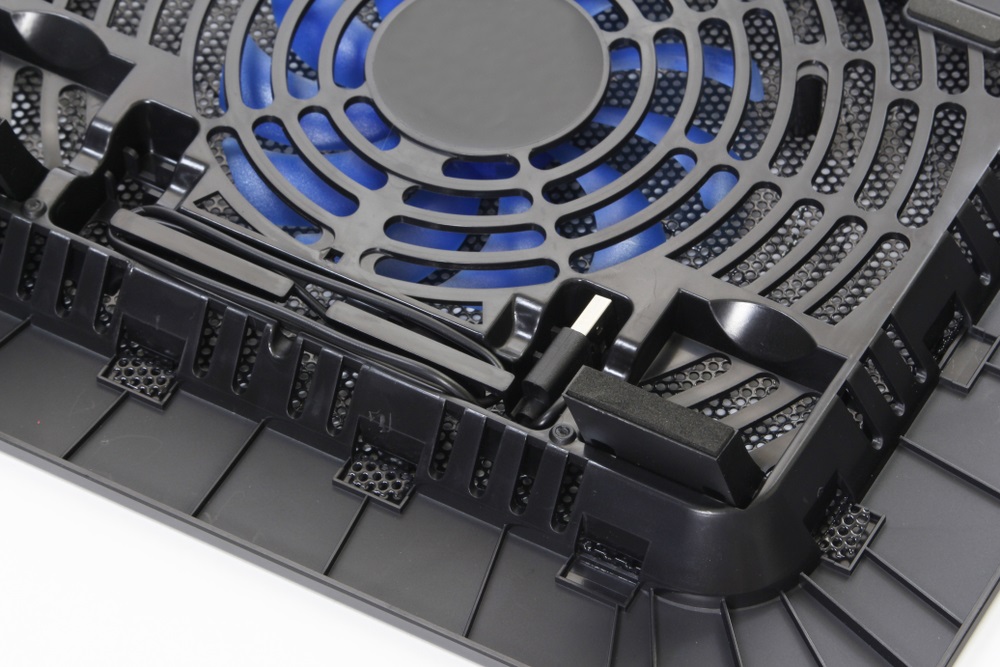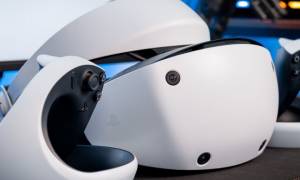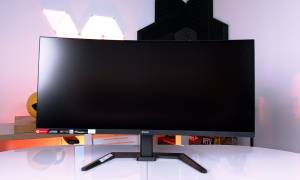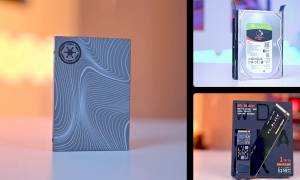This blog was updated in October 2022.
- A cooling pad can help, but only to a limited extent.
- The big fan of a cooling pad might look impressive. In practice, however, it’s not doing much.
- The biggest gain from using a cooling pad comes from simply raising the laptop up, allowing for greater air circulation.
Gaming laptops get hot, sometimes worryingly so. There are safety measures in place to ensure a gaming laptop’s hardware doesn’t get so hot that it damages itself. Nonetheless, when you’re coming from a high-airflow gaming PC that barely exceeds 70°C even under a heavy load, it’s unnerving to see a gaming laptop creep up to the mid-90°Cs.
With such a high temperature, dynamic frequency scaling (or ‘thermal throttling’) would’ve kicked in. This helps reign in temperatures by dropping clock speeds, but now you’re yielding performance on what’s supposed to be a performance-focused device. It’s a trade-off no-one wants to make.
So, how do you keep temperatures in check? One potential way is to use a laptop cooling pad.
What is a cooling pad?

A cooling pad is an accessory that you place your gaming laptop on. Like a laptop stand or riser, a cooling pad has adjustable feet to raise it up from your desk.
This improves air circulation around the intakes and exhausts. Unlike these other accessories, however, cooling pads also have USB-powered fans. By blowing air right onto your laptop, a cooling pad can, supposedly, reduce temperatures.
Basic cooling pads are equipped with a single fans. Invest a bit extra and you can get cooling pads with several fans, USB hubs and passthrough (so you don’t lose any USB slots by plugging it in) and, of course, RGB lighting.
Why would you want a cooling pad?

A gaming laptop packs high-performance hardware into a cramped space. We’re talking about CPUs and GPUs that can run the latest, most graphically intensive games at high resolutions and frame rates, in a portable device that’s slim enough for a backpack.
It’s remarkable how much performance you can squeeze into modern game laptops. Who would’ve thought you’d be able to run real-time raytracing on a laptop just a few years ago?
But compared to a desktop, or even a console, a gaming laptop just doesn’t have enough room for a great cooling solution.
Look at the sheer size of a desktop GPU alone (like a four-slot thick RTX 4090) and line it up against a gaming laptop’s entire heatsink. It’s cooling the CPU and as well as the GPU, while vying for space with the mainboard, battery, and more.
So, it’s no wonder a gaming laptop gets hot. When your desktop PC is overheating, there are several ways to address it: upgrading to a high-airflow computer case, adding more case fans, investing into water cooling, and more.
A gaming laptop is extremely limited in this regard, but they need any help they can get. That’s where cooling pads come in, as one of the few potential fixes. But the question is, do they even work?
Do cooling pads work?
A cooling pad can help reduce temperatures, but the degree to which it does so may leave you underwhelmed. As a cooling pad isn’t in direct contact with the internal hardware, you’ve got to set your expectations accordingly. It’s not a magic solution that fixes overheating, but a cooling pad can have an effect, if marginal.
By now, you might be wondering what’s the point of a laptop’s cooling fan? Surely gaming laptops have their own fans already, so you’re just stacking one fan on top of another. And that’s the problem with cooling pads.
Strapping a big fan to the bottom of your laptop might look impressive, but in practice it’s likely not doing much at all. Again, it’s not as if this fan is blowing fresh air onto the components themselves.
Most of it’s going to be blocked by the laptop’s chassis anyway. If your laptop has plenty of large intakes, then this fan may act as a small aid. Many laptops only have a couple intakes, however, which are already occupied with fans.
Really, what a cooling pad does best is just raising the laptop up so more air can circulate underneath it. This is partly why laptops have rubberised feet already. Not only do they help stop a laptop from slipping, but they also create a gap for air to be drawn into. This small gap may provide enough air for a low-powered laptop, but for a high-performance gaming laptop it’s suffocating.
Gaming laptops often end up cycling through the same hot air, so the hardware can’t cool down properly. It’s the same problem as storing a console in a cramped TV stand, or placing a desktop PC on thick carpet.
Air circulation is key

Cooling pad, stand, or riser – any accessory helps.
On the other hand, a cooling pad raises a laptop up by a good few centimetres. That’s a big gap in comparison. They’re usually made of a perforated metal, allowing fresh air to circulate around the gaming laptop freely. And with the cooling solution no longer starved for air, it can do its job better.
Yes, you can achieve largely the same effect as a cooling pad by propping your laptop up with some stacked books. A cooling pad is a less fiddly, more permanent solution, however. What’s more, if you’re not using an external monitor, a cooling pad raises the display to as more comfortable height as well.
Should I buy a cooling pad?
Even if cooling pads lower temperatures by a few degrees at most (don’t expect more than 5°C in most cases), it’s nothing to scoff at. If a gaming laptop is right at the cusp of thermal throttling, the few degrees of temperature reduction a cooling pad affords could save the day.
In that case, a cooling pad (or anything that props you gaming laptop for that matter) is worth it. Check out Ebuyer’s range of laptop accessories. Between the high temperatures and thermal throttling, is a gaming laptop worth it?



























